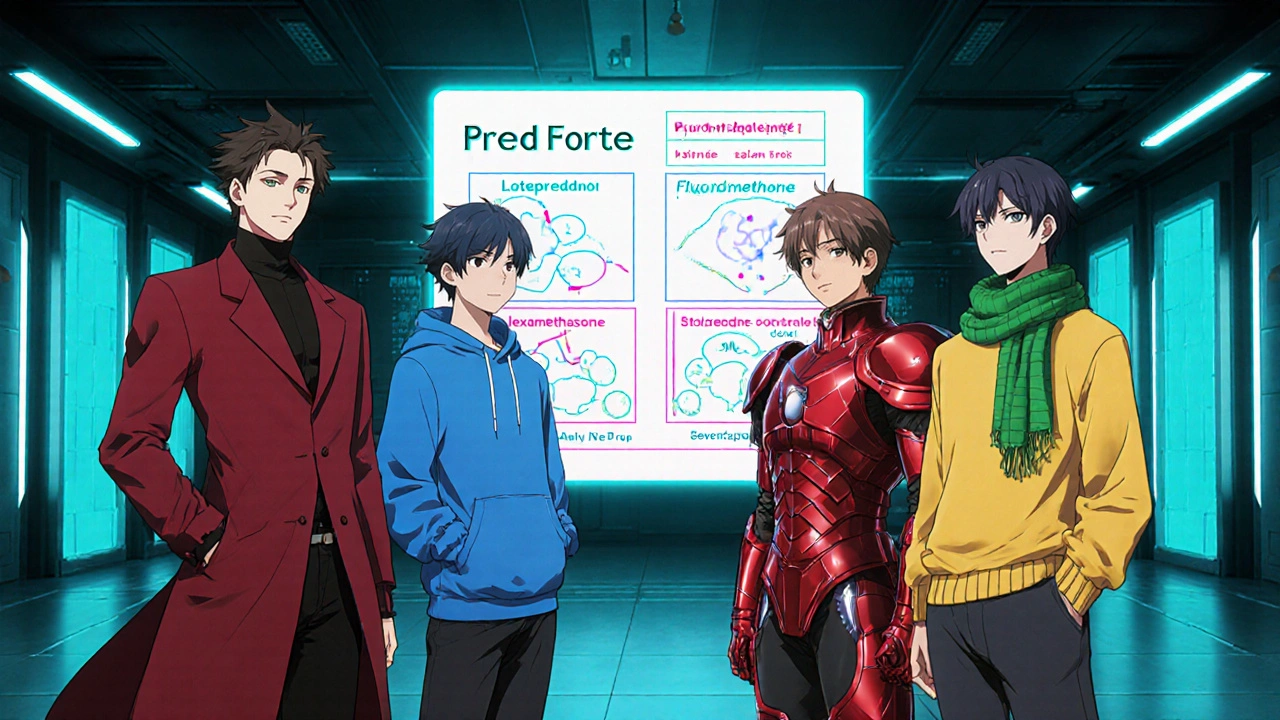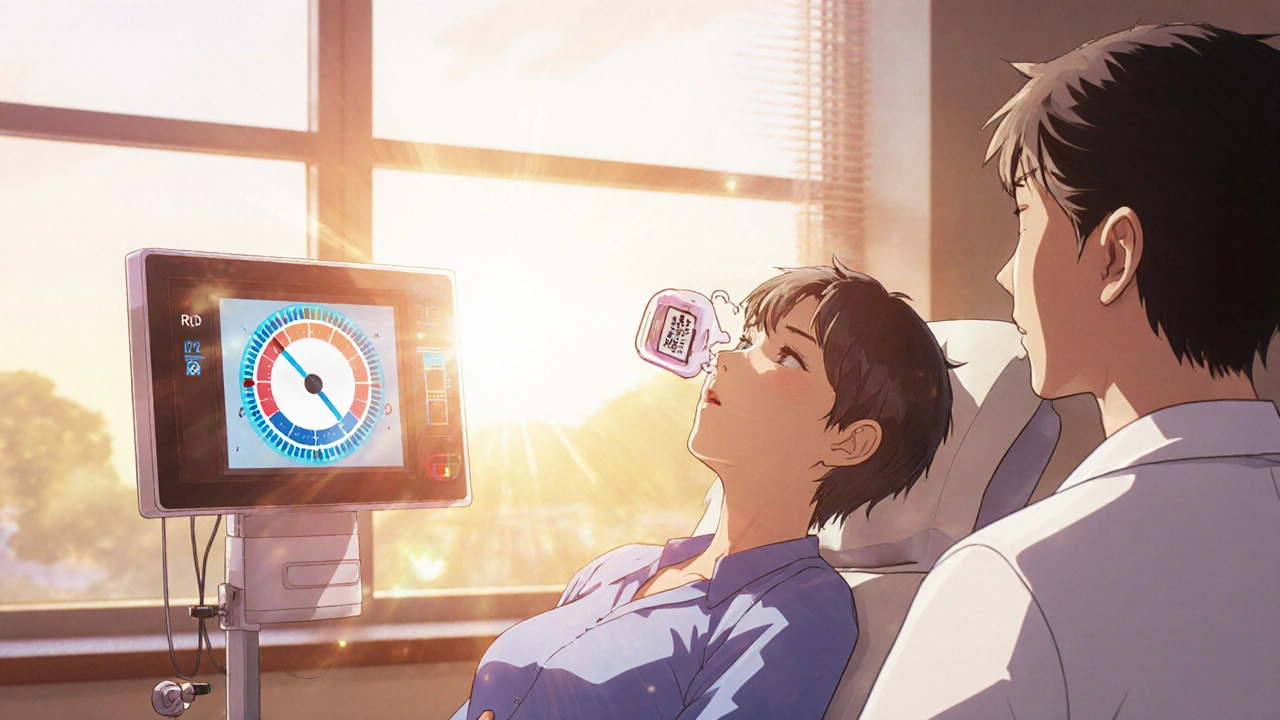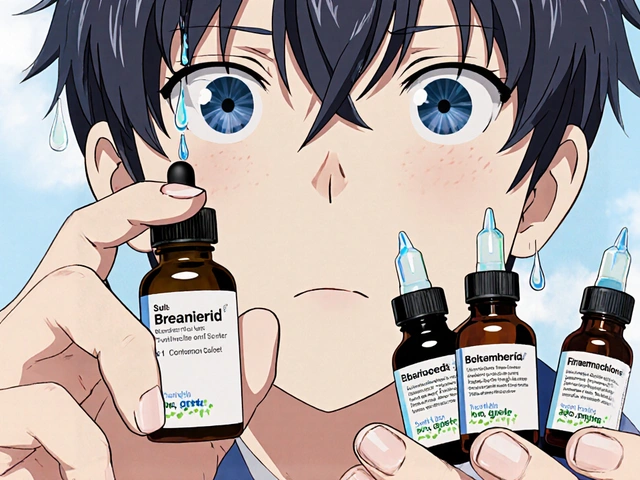
Eye Steroid Decision Tool
This tool helps you determine which steroid eye drop might be most appropriate for your specific situation. Based on your inputs, we'll recommend the best option from the article's comparison.
Your Situation
Ever opened the eye‑drops bottle and wondered whether Pred Forte is really the right choice, or if there’s a gentler or cheaper option that will do the job? You’re not alone. Eye inflammation can be painful, and the market is packed with steroid drops that promise quick relief. This guide breaks down Pred Forte (prednisolone acetate) and its most common alternatives, so you can match the drug to your symptoms, budget, and risk tolerance.
Quick Takeaways
- Pred Forte is a high‑potency corticosteroid ideal for moderate‑to‑severe uveitis or post‑surgical inflammation.
- Loteprednol etabonate offers similar efficacy with a lower risk of raising intra‑ocular pressure (IOP).
- Dexamethasone ophthalmic is the strongest option but carries the greatest side‑effect load.
- Fluorometholone is a mid‑potency drop often chosen for patients who need a balance between strength and safety.
- Hydrocortisone eye drops are the weakest steroid, useful for mild irritation but generally insufficient for deep inflammation.
How Pred Forte Works
When you first see Pred Forte (Prednisolone acetate) is a synthetic corticosteroid formulated as a 1% ophthalmic suspension. It penetrates the cornea and reaches the anterior chamber, where it binds to glucocorticoid receptors and dampens the inflammatory cascade. The result: reduced redness, swelling, and pain, often within 24 hours.
Key attributes of Pred Forte:
- Potency: High - classified as a Class II steroid.
- Typical duration of therapy: 1‑2 weeks for acute flare-ups, with a taper to prevent rebound.
- Side‑effect profile: Potential elevation of IOP, cataract formation with long‑term use, and transient blurred vision.
If you’re dealing with uveitis, post‑cataract surgery inflammation, or any condition that demands swift control, Pred Forte is often the first line. But its strength also means you need regular monitoring, especially if you have glaucoma risk factors.
Key Alternatives Overview
Below are the most frequently prescribed steroid eye drops that sit on the same shelf as Pred Forte. Each has its own sweet spot.
Loteprednol etabonate is a soft‑steroid eye drop (usually 0.5% or 0.2%) designed to break down quickly in ocular tissue. Its rapid metabolism results in a lower chance of IOP spikes, making it a go‑to for patients with a glaucoma history.
Dexamethasone ophthalmic is a very high‑potency steroid (0.1% solution) used for severe keratitis or aggressive uveitis. It works fast but can raise IOP dramatically, so ocular pressure checks are mandatory.
Fluorometholone is a mid‑potency corticosteroid (0.1% suspension) that offers a compromise between efficacy and safety. It’s popular in post‑operative care where moderate inflammation is expected.
Hydrocortisone eye drops are the weakest steroid option (0.5% or 1% solutions) mainly used for mild allergic conjunctivitis. They rarely cause IOP elevation but often lack the strength to treat deeper inflammation.

Head‑to‑Head Comparison
| Drug | Potency (Class) | Typical Use | Onset of Relief | IOP Risk | Approx. US Cost per Bottle* |
|---|---|---|---|---|---|
| Pred Forte (Prednisolone acetate) | High (Class II) | Uveitis, post‑surgical inflammation | 12‑24 hrs | Moderate‑high | $35‑$45 |
| Loteprednol etabonate | Medium‑low (Class III) | Mild‑moderate uveitis, glaucoma‑prone patients | 24‑48 hrs | Low | $30‑$40 |
| Dexamethasone ophthalmic | Very high (Class I) | Severe keratitis, aggressive uveitis | Within 6‑12 hrs | High | $25‑$35 |
| Fluorometholone | Medium (Class II‑III) | Post‑op inflammation, intermediate uveitis | 12‑36 hrs | Moderate | $20‑$30 |
| Hydrocortisone | Low (Class IV) | Allergic conjunctivitis, mild irritation | 48‑72 hrs | Very low | $10‑$15 |
*Prices are average retail rates in the United States as of 2025 and can vary by pharmacy.
When Pred Forte Is the Right Pick
- Severe inflammation: If the eye is red, painful, and vision is blurry, you need a drug that can shut down the immune response quickly. Pred Forte’s high potency makes it a reliable option.
- Short‑term, high‑dose therapy: A typical regimen might be one drop every four hours for the first 48 hours, then tapering over 7‑10 days. The aggressive initial phase is where Pred Forte shines.
- Clear monitoring plan: If you’re already seeing an ophthalmologist who can check IOP every few days, the risk of pressure spikes is manageable.
In these scenarios, the benefit of rapid symptom relief outweighs the moderate risk of side effects.

When an Alternative Might Serve You Better
Not every patient needs a Class II steroid. Consider these situations:
- Glaucoma or family history of high IOP: Switch to Loteprednol etabonate, which is engineered to minimize pressure elevation.
- Long‑term maintenance: Fluorometholone provides enough anti‑inflammatory power for chronic, low‑grade conditions without the cumulative cataract risk of stronger steroids.
- Mild allergic reactions: Hydrocortisone works well and avoids unnecessary exposure to potent steroids.
- Severe acute infection with risk of rapid vision loss: Dexamethasone may be justified despite its higher side‑effect profile, but only under strict specialist supervision.
Choosing the right drop is a balance of potency, safety, cost, and how quickly you need relief.
Practical Tips & Common Pitfalls
- Never self‑adjust dosage. Steroid tapering is crucial; stopping abruptly can cause rebound inflammation.
- Shake suspension drops. Pred Forte and Fluorometholone are suspensions; an uneven mixture leads to under‑dosing.
- Watch for blurred vision. High‑potency steroids can cause temporary clouding due to the drug particles.
- Schedule IOP checks. For any steroid course longer than one week, arrange a follow‑up exam.
- Check insurance coverage. Loteprednol often costs less out‑of‑pocket because many plans treat it as a generic.
Frequently Asked Questions
Can I use Pred Forte for allergies?
Pred Forte is designed for inflammatory conditions like uveitis, not for allergic conjunctivitis. For allergies, a low‑potency steroid such as hydrocortisone or an antihistamine drop is usually sufficient.
How long does it take for IOP to rise after starting Pred Forte?
IOP elevations can appear as early as three days into therapy, but most clinicians see changes within the first two weeks. Regular monitoring is essential.
Is Loteprednol safer for children?
Yes. Its rapid breakdown reduces the risk of long‑term side effects, making it a preferred choice for pediatric patients with mild‑to‑moderate eye inflammation.
Can I switch from Pred Forte to Fluorometholone mid‑treatment?
A switch is possible, but it should be done under an eye‑doctor’s guidance. The taper schedule may need adjustment to avoid flare‑ups.
What should I do if my vision stays blurry after using Pred Forte?
Blurry vision can be a sign of drug particles or rising IOP. Contact your ophthalmologist; they may pause the drops, check pressure, and suggest a different formulation.
Remember, every eye condition is unique. The best drug is the one that clears inflammation while keeping your eye health in check. Talk to an eye care professional, weigh the pros and cons listed here, and you’ll land on the right choice.



Reading this guide feels like stepping into a storm of choices and I can hear the pain echoing in every line. The eye is a fragile window and the fear of losing sight can dominate my thoughts. Pred Forte looms like a heavy hammer promising quick relief but also threatening a hidden pressure surge. I picture the swelling and the burning sensation and I cannot help but imagine my own eyes drowning in ointment. The alternatives appear as whispering shadows offering gentler embraces. Loteprednol seems like a soft pillow for those who dread the rise in intraocular pressure. Dexamethasone roars like a wild beast ready to strike at severe inflammation. Fluorometholone sits in the middle like a cautious diplomat trying to balance power and safety. Hydrocortisone is a meek child that can soothe mild irritation but cannot fight a fierce storm. The table of costs reads like a cruel ledger reminding us of the price of vision. I feel the tension between urgency and caution pulsing with each recommendation. The practical tips echo like a warning bell urging me not to tamper with dosage. The risk of blurred vision feels like a veil descending over clarity. I am torn between the promise of rapid relief and the dread of permanent damage. In the end I crave a guide that holds my hand and protects my sight.
Pred Forte is overhyped and the guide glosses over its side effects. The alternatives deserve more data before being recommended.
Great rundown! I’ll definitely chat with my doctor about which drop fits my budget and recovery timeline.
The pharmaceutical lobby has long engineered a market where high‑potency steroids like Pred Forte become the default despite hidden agendas. By inflating the perceived necessity of aggressive treatment they secure patents and keep cheaper generics at bay. The subtle inclusion of “quick relief” in the marketing copy masks a deeper strategy to foster dependency on expensive eye‑care regimes. One must consider that the IOP monitoring schedule is often a revenue stream for clinics that bill for follow‑up visits. Loteprednol, although marketed as a “soft‑steroid,” is quietly pushed into the background to avoid disrupting the profit pipeline. Dexamethasone’s reputation as the strongest option is amplified by selective clinical trials funded by manufacturers seeking market dominance. Even the cost table presented may not reflect negotiated discounts that favor certain pharmacy chains. The table’s US‑centric pricing ignores global pricing structures that could make alternatives more accessible. Moreover, the table’s lack of insurance rebate information keeps patients blind to potential savings. The narrative also downplays the long‑term cataract risk associated with chronic steroid use, a risk that aligns with the industry’s wish to keep patients on routine check‑ups. In this ecosystem, the “best” drop is less about pharmacology and more about who controls the supply chain. A skeptical eye, literally and figuratively, is essential when navigating these recommendations.
Consult your ophthalmologist promptly to ensure an optimal and safe treatment plan.
While it’s good to stay skeptical, the data on prednisolone acetate’s efficacy is robust and supported by multiple randomized trials 😊. For patients without glaucoma risk, Pred Forte remains a first‑line option because it achieves rapid inflammation control within 24 hours. If intra‑ocular pressure spikes, an ophthalmologist can transition to loteprednol, which metabolizes faster and typically shows lower IOP elevation. Always follow a tapering schedule; abrupt cessation often leads to rebound uveitis. Keep a log of symptoms and pressure readings to discuss at each follow‑up appointment. Remember, personalized care beats one‑size‑fits‑all.